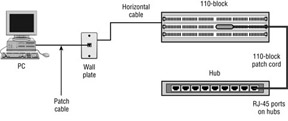The following advantages of fiber over other cabling systems explain why fiber is becoming the preferred network cabling medium for high-bandwidth, long-distance applications:
- Immunity to electromagnetic interference (EMI)
- Higher data rates
- Longer maximum distances
- Better security
Immunity to Electromagnetic Interference (EMI)
All copper-cable network media share one common problem: they are susceptible to EMI. EMI is stray electromagnetism that interferes with electrical data transmission. All electrical cables generate a magnetic field around their central axis. If you pass a metal conductor through a magnetic field, an electrical current is generated in that conductor.
When you place two copper communication cables next to each other, EMI will cause crosstalk; signals from one cable will be picked up on the other. The longer a particular copper cable is, the more chance for crosstalk.
Fiber-optic cabling is immune to crosstalk because optical fiber does not conduct electricity and uses light signals in a glass fiber, rather than electrical signals along a metallic conductor, to transmit data. So it cannot produce a magnetic field and thus is immune to EMI. Fiber-optic cables can therefore be run in areas considered to be "hostile" to regular copper cabling (such as elevator shafts, electrical transformers, in tight bundles with other electrical cables, and industrial machinery).
Higher Possible Data Rates
Because light is immune to interference, can be modulated at very high frequencies, and travels almost instantaneously to its destination, much higher data rates are possible with fiber-optic cabling technologies than with traditional copper systems. Data rates far exceeding the gigabit per second (Gbps) range and higher are possible, and the latest IEEE standards body is working on 100Gbps fiber-based applications over much longer distances than copper cabling. Multimode is the preferred fiber-optic type for 100–550 meters seen in LAN networks, and since single-mode fiber-optic cables are capable of transmitting at these multi-gigabit data rates over very long distances, they are the preferred media for transcontinental and oceanic applications.
You will often encounter the word "bandwidth" when describing fiber-optic data rates. With optical fiber, bandwidth does not refer to channels or frequency, but rather just the bit-throughput rate.
Longer Maximum Distances
Typical copper data-transmission media are subject to distance limitations of maximum segment lengths no longer than 100 meters. Because they don't suffer from the EMI problems of traditional copper cabling and because they don't use electrical signals that can degrade substantially over long distances, single-mode fiber-optic cables can span distances up to 75 kilometers (about 46.6 miles) without using signal-boosting repeaters.
Better Security
Copper-cable transmission media are susceptible to eavesdropping through taps. A tap (short for wiretap) is a device that punctures through the outer jacket of a copper cable and touches the inner conductor. The tap intercepts signals sent on a LAN and sends them to another (unwanted) location. Electromagnetic (EM) taps are similar devices, but rather than puncturing the cable, they use the cable's magnetic fields, which are similar to the pattern of electrical signals. If you'll remember, simply placing a conductor next to a copper conductor with an electrical signal in it will produce a duplicate (albeit lower-power) version of the same signal. The EM tap then simply amplifies that signal and sends it on to the person who initiated the tap.
Because fiber-optic cabling uses light instead of electrical signals, it is immune to most types of eavesdropping. Traditional taps won't work because any intrusion on the cable will cause the light to be blocked and the connection simply won't function. EM taps won't work because no magnetic field is generated. Because of its immunity to traditional eavesdropping tactics, fiber-optic cabling is used in networks that must remain secure, such as government and research networks.
























